
Massachusetts Avenue is a major diagonal transverse road in Washington, D.C., and the Massachusetts Avenue Historic District is a historic district that includes part of it.

Petworth is a residential neighborhood in the Northwest quadrant of Washington, D.C. It is bounded to the east by the Armed Forces Retirement Home and Rock Creek Cemetery, to the west by Arkansas Avenue NW, to the south by Rock Creek Church Road NW and Spring Road NW, and to the north by Kennedy Street NW.
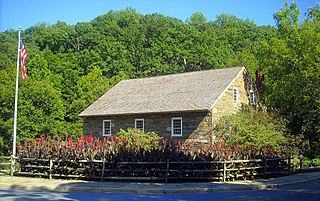
This is a list of properties and districts in the District of Columbia on the National Register of Historic Places. There are more than 600 listings, including 74 National Historic Landmarks of the United States and another 13 places otherwise designated as historic sites of national importance by Congress or the President.

Old Town Chinatown is the official Chinatown of the Northwest section of Portland, Oregon. The Willamette River forms its eastern boundary, separating it from the Lloyd District and the Kerns and Buckman neighborhoods. It includes the Portland Skidmore/Old Town Historic District and the Portland New Chinatown/Japantown Historic District, which are listed on the National Register of Historic Places.

The Northwest District is a densely populated retail and residential neighborhood in the northwest section of Portland, Oregon. Craftsman-style and Old Portland-style houses are packed tightly together with grand old apartment buildings and sleek new condominiums, within walking distance of restaurants, bars, and shops. The Portland Streetcar's first line terminates there, connecting the district to the Pearl District, Downtown Portland and points south to the South Waterfront, and several TriMet bus lines also serve the district.

The Old Dauphin Way Historic District is a historic district in the city of Mobile, Alabama, United States. It was named for Dauphin Way, now known as Dauphin Street, which bisects the center of the district from east to west. The district is roughly bounded by Broad Street on the east, Springhill Avenue on the north, Government Street on the south, and Houston Avenue on the west. Covering 766 acres (3.10 km2) and containing 1466 contributing buildings, Old Dauphin Way is the largest historic district in Mobile.

The Midtown Historic District is a historic district in the city of Mobile, Alabama, United States. It was placed on the National Register of Historic Places on November 29, 2001. It is roughly bounded by Taylor Avenue, Government Street, Houston Street, Kenneth Street, Springhill Avenue, and Florida Street. The district covers 467 acres (1.89 km2) and contains 1,270 contributing buildings. The majority of the contributing buildings range in age from the 1880s to the 1950s and cover a wide variety of architectural styles. The district was significantly affected by a tornado on December 25, 2012.
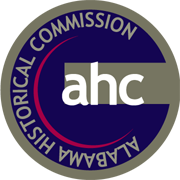
The Alabama Historical Commission is the historic preservation agency for the U.S. state of Alabama. The agency was created by an act of the state legislature in 1966 with a mission of safeguarding Alabama’s historic buildings and sites. It consists of twenty members appointed by the state governor or who serve in an official position. The members represent a broad cross section of Alabamians including architects, historians, archaeologists, and representatives of state universities. The commission is tasked with acquisition and preservation of historic properties and education of the public about historic sites in Alabama.
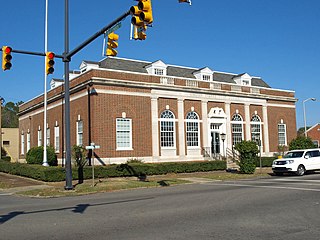
The Post Office Historic District is a historic district in Greenville, Alabama at 100-115 West Commerce and 101 East Commerce Streets. It was listed on the National Register of Historic Places in 1986 and includes Early Commercial architecture, Classical Revival architecture, and Art Deco architecture in its nine contributing buildings.

The Lowndesboro Historic District is a historic district in Lowndesboro, Alabama, United States. It was placed on the National Register of Historic Places on December 12, 1973. The district covers 1,800 acres (730 ha), spread over the entire town, and contains 20 contributing properties, including Meadowlawn Plantation. Architectural styles include the Gothic Revival, Greek Revival, and other Victorian styles.

The Gainesville Historic District is a historic district that encompasses a historic section of Gainesville, Alabama, United States. The district was listed on the Alabama Register of Landmarks and Heritage on March 25, 1976 and the National Register of Historic Places on October 3, 1985. The district covered 76 acres (31 ha) and contained 24 historically significant contributing properties when first listed.

The Fifteenth Street Financial Historic District is a historic district in Washington, D.C. that was listed on the National Register of Historic Places in 2006, and modified to the Financial Historic District in 2017. It includes works of Beaux Arts and other architecture by several architects, in 20 contributing buildingsbuilt between 1835 and 1940.This building is a linear district of monumental Beaux Arts Classicist commercial buildings notable both individually and as an extraordinarily cohesive ensemble.
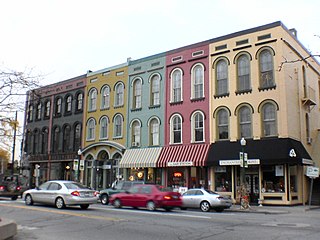
The Ypsilanti Historic District is a historic district located along several blocks on each side of the Huron River in the center of Ypsilanti, Michigan. The original portion of the district was designated a Michigan State Historic Site in 1973 and listed on the National Register of Historic Places in 1978; additions to the district were nationally listed in 1989.
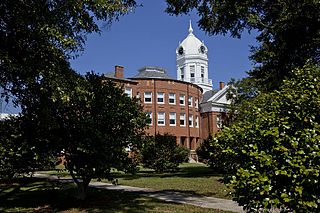
The Monroeville Downtown Historic District is a 40-acre (16 ha) historic district in downtown Monroeville, Alabama. It is centered on the courthouse square and the streets that border it. The streets include Claiborne Street on the south, Alabama Avenue on the east, Pineville Road on the north and Mount Pleasant Avenue on the west. The district includes examples of the Classical Revival, American Craftsman, Moderne, and other residential and commercial architectural styles. It contains 63 structures, with 51 of them listed as contributing buildings. It was added to the National Register of Historic Places on September 16, 2009.

The Main–Yankee Street Historic District is a historic district that encompasses an antebellum residential section of Gainesville, Sumter County, Alabama. The district was listed on the National Register of Historic Places on October 3, 1985. It covers 6.5 acres (2.6 ha) and contains five historically significant contributing properties, all predating the American Civil War.

The Old Town Historic District is a 323-acre (131 ha) historic district in Selma, Dallas County, Alabama. It is bounded by U.S. Route 80, Broad and Franklin streets, and Dallas and Selma avenues. The boundaries were increased on December 15, 2003. The district includes examples of the Federal, Greek Revival, Italianate, Gothic Revival, Victorian, Shotgun, Queen Anne, Romanesque Revival, Renaissance Revival, and Classical Revival. It contains 629 properties, with 513 contributing and 116 noncontributing to the district. It was added to the National Register of Historic Places on May 3, 1978.

The Childress Commercial and Civic Historic District is a 110 acres (45 ha) historic district in Childress, Texas which was listed on the National Register of Historic Places in 2016. The district includes 93 contributing buildings, five contributing structures, three contributing sites, and two contributing objects, as well as 30 non-contributing buildings.

The Louisville Commercial Historic District, in Louisville, Georgia, is a historic district which was listed on the National Register of Historic Places in 1994.

The University of Montevallo Historic District is a historic district listed on the National Register of Historic Places. It consists of the central part of what is now University of Montevallo, in Montevallo in Shelby County, Alabama.

The West Old Town Historic District, in or near Decatur, Alabama, is a historic district which was listed on the National Register of Historic Places in 2012.























